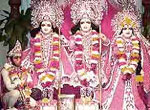Introduction:
The Bhagavad Gita (Sanskrit: भगवद्गीता, Song of God), also more simply known as Gita, is a 700-verse Hindu scripture that is part of the ancient Sanskrit epic Mahabharata. Since the Gita is drawn from the Mahabharata, it is classified as a Smṛiti text. However, those branches of Hinduism that give it the status of an Upanishad also consider it a Śruti or "revealed" text. As it is taken to represent a summary of the Upanishadic teachings, it is also called "the Upanishad of the Upanishads."The context of the Gita is a conversation between Lord Krishna and the Pandava prince Arjuna taking place in the middle of the battlefield before the start of the Kurukshetra War with armies on both sides ready to battle. Responding to Arjuna's confusion and moral dilemma about fighting his own cousins who command a tyranny imposed on a disputed empire, Lord Krishna explains to Arjuna his duties as a warrior and prince, and elaborates on yoga, Samkhya,reincarnation, moksha, karma yoga and jnana yoga among other topics.
Overview Of Chapters:
Arjuna-Visada Yoga: Arjuna requests Krishna to move his chariot between the two armies. When Arjuna sees his relatives on the opposing army side of the Kurus, he loses morale and decides not to fight.The Gita consists of eighteen chapters in total:
- Sankhya Yoga:: After asking Krishna for help, Arjuna is instructed that only the body may be killed, as he was worried if it would become a sin to kill people (including his gurus and relatives), while the eternal self is immortal. Krishna appeals to Arjuna that, as a warrior, he has a duty to uphold the path of dharma through warfare. Krishna told Arjuna the three principles dharma, Atman and the Sharira(Body).
- Karma Yoga: Arjuna asks why he should engage in fighting if knowledge is more important than action. Krishna stresses to Arjuna that performing his duties for the greater good, but without attachment to results, is the appropriate course of action.
- Karma -Sanyasa Yoga: Krishna reveals that he has lived through many births, always teaching Yoga for the protection of the pious and the destruction of the impious and stresses the importance of accepting a guru.
- Dnyan-Karma-Sanyasa Yoga: Arjuna asks Krishna if it is better to forgo action or to act ("renunciation or discipline of action"). Krishna answers that both ways may be beneficent, but that acting in Karma Yoga is superior.
- Atmasanyam Yoga: Krishna describes the correct posture for meditation and the process of how to achieve Samādhi.
- Dnyana-Vijnana Yoga: Krishna teaches the path of knowledge (Jnana Yoga).
- Aksara-Brahma Yoga: Krishna defines the terms brahman, adhyatma, karma, atman, adhibhuta and adhidaiva and explains how one can remember him at the time of death and attain his supreme abode.
- Raja-Vidya-Raja-Guhya Yoga: Krishna explains panentheism, "all beings are in me" as a way of remembering him in all circumstances.
- Vibhuti-Vistara-Yoga: Krishna describes how he is the ultimate source of all material and spiritual worlds. Arjuna accepts Krishna as the Supreme Being, quoting great sages who have also done so.
- Visvarupa-Darsana Yoga: On Arjuna's request, Krishna displays his "universal form" (Viśvarūpa), a theophany of a being facing every way and emitting the radiance of a thousand suns, containing all other beings and material in existence.
- Bhakti Yoga: Krishna describes the process of devotional service (Bhakti Yoga).
- Ksetra-Ksetrajna Vibhaga Yoga: Krishna describes nature (prakrti), the enjoyer (purusha) and consciousness.
- Gunatraya-Vibhaga Yoga: Krishna explains the three modes (gunas) of material nature.
- Purusottama Yoga: Krishna describes a symbolic tree (representing material existence), its roots in the heavens and its foliage on earth. Krishna explains that this tree should be felled with the "axe of detachment", after which one can go beyond to his supreme abode.
- Daivasura-Sampad-Vibhaga Yoga: Krishna tells of the human traits of the divine and the demonic natures. He counsels that to attain the supreme destination one must give up lust, anger and greed, discern between right and wrong action by discernment through Buddhi and evidence from scripture and thus act correctly.
- Sraddhatraya-Vibhaga Yoga: Krishna tells of three divisions of faith and the thoughts, deeds and even eating habits corresponding to the three gunas.
- Moksa-Sanyasa Yoga: In conclusion, Krishna asks Arjuna to abandon all forms of dharma and simply surrender unto him. He describes this as the ultimate perfection of life.






 Sri-Ramnavami is dedicated to the memory of Lord Rama. It occurs on the ninth day (navami). The festival commemorates the birth of Rama who is remembered for his preperous and righteous reign. Ramrajya (the reign of Rama) has become synonymous with a period of peace and prosperity.
Sri-Ramnavami is dedicated to the memory of Lord Rama. It occurs on the ninth day (navami). The festival commemorates the birth of Rama who is remembered for his preperous and righteous reign. Ramrajya (the reign of Rama) has become synonymous with a period of peace and prosperity.
